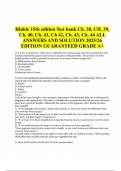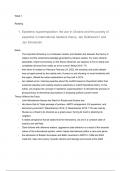Samenvatting
Summary Oncology Molecular Biology of Cancer chapter 1-6
- Instelling
- Vrije Universiteit Amsterdam (VU)
This is a summary of Molecular Biology of Cancer chapter 1-6. This is the perfect summary to prepare yourself for the first exam in the Oncology course. It contains figures and detailed explanations. My exam grade was an 8!
[Meer zien]














